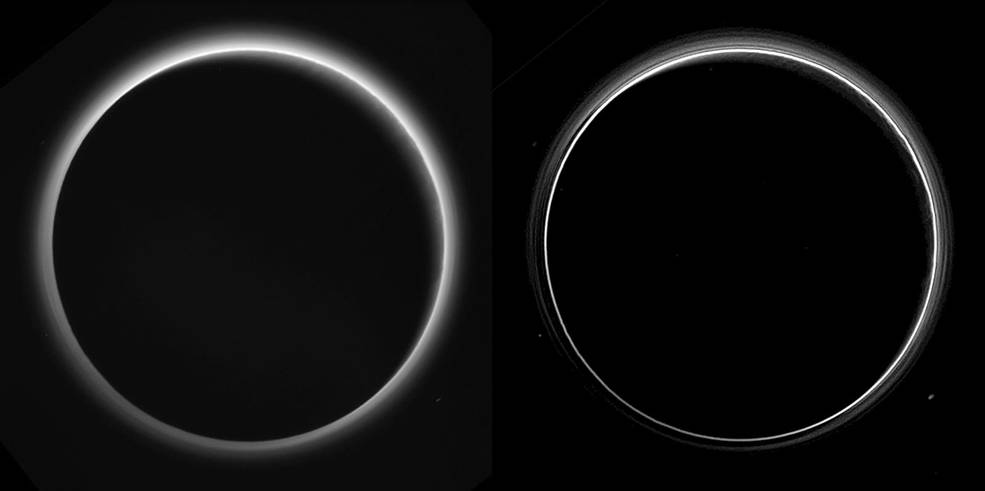

Above, you see the latest image of Pluto. It was released today as part of a data dump received from NASA’s New Horizons probe, which flew by the tiny dwarf back on July 14th, 2015. The pictures that the spacecraft returned so far are simply staggering; however, because the craft is so far away from Earth, it will take more than a year to receive all of the data. But already, we see that Charon is round and pockmarked, and we see that pluto has a heart splashed across its surface.
And the latest releases reveal a whole new world.
The cratered surface that we see here comes from when New Horizons was just 50,000 miles (80,000 kilometers) away from Pluto, and they show a world that has been brutalized by collisions. The surface features, which stand out in stark detail, have double the amount of Pluto’s surface that we can see; they provide highly detailed resolutions of craters and cracks along the surface (some resolutions are as good as 400 meters [440 yards] per pixel). We also see vast, frozen plains.
Because it is so far out in the solar system, the temperature on Pluto hovers around a chilly -373F (-272C). Not too surprising, seeing as it is in a frozen wasteland some 3.6 billion miles (5.9 billion km) from our life giving star. However, unlike the other major planets in our solar system, Pluto has an orbit that is highly elliptical. Each revolution, Pluto swings in towards the Sun, and as it hurtles closer to our star, the dwarf planet heats up and develops a thin atmosphere. Following this, it careens out towards the farthest reaches of the solar system…freezing…becomi
This creates some pretty interesting activity on the icy world – activity that (scientists hope) these images may allow us to better understand.

The image of Charon, Pluto’s largest moon, that is pictured above was taken 10 hours before New Horizons’ closest approach to the dwarf planet. Improved images of some of Pluto’s moons (Charon, Nix, and Hydra – it has 5 all in all) are set to be released Friday at the raw images site for New Horizons’ Long Range Reconnaissance Imager (LORRI).
As an interesting aside, a few years ago, the SETI Institute (the Search for Extraterrestrial Intelligence) held a vote to rename P4 and P5 (two of Pluto’s moons). The first winning name in this contest was Cerberus, which was the three-headed hellhound who, in Greek and Roman mythology, guarded the gates to the Underworld. The second was Vulcan, after the mythological god of Fire..ironic, as the moon is so cold.

In the end, the newly released images of this war-ravaged world seem rather fitting – because Pluto, as we all know, has a rather long and turbulent history.
It was discovered in 1930 by Clyde W. Tombaugh. The scientific community quickly heralded it as the 9th planet in our solar system. Then, thanks to its highly elliptical orbit, from 1979 to 1999 it was the 8th planet in our solar system. And in 1999 it once again became the 9th planet in our solar system. It was to be the 9th planet for another 200 years (until about 2199), at which point it would again become the 8th planet…and so on and so on.
But of course, things changed. In 2006 Pluto was reclassified as a dwarf planet.
However, these images show us that Pluto is just as exciting and dynamic as any of the 8 planets that dominate our solar system, and the images only add to the discoveries that we’ve made over the last few weeks and months. Perhaps the most notable discovery that New Horizons’ showed us is that Pluto has its own claim to fame: A plasma tail.
That news came thanks to the SWAP instrument (Solar Wind Around Pluto). As it passed, the tool picked up readings showing a depression, and as it turns out, this depression is filled with nitrogen ions lagging behind Pluto. Ultimately, solar winds strip away rather massive portions of Pluto’s atmosphere, which then trails behind the tiny dwarf planet.

But for me, the best images aren’t the pockmarked surface. Rather, the above image is the most stunning. Here, we see the aforementioned layers of Pluto’s hazy atmosphere – They stand out amidst an inky world that is circled by the light of a star that is billions and billions of miles away.
These photos were taken by New Horizons as it looked back at Pluto’s “dark side” just 16 hours after its closest approach. At the time, it was 480,000 miles (770,000 kilometers) from Pluto.